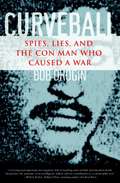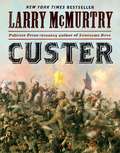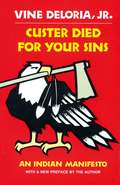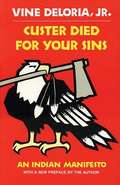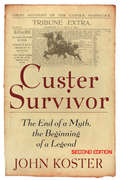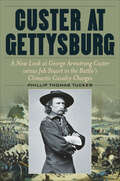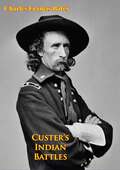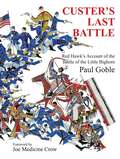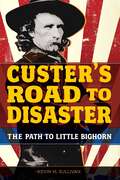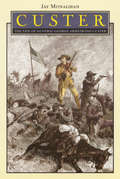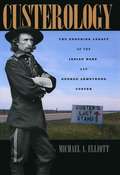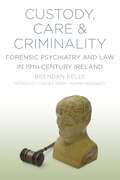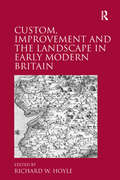- Table View
- List View
Curveball: Spies, Lies, and the Con Man Who Caused a War
by Bob DroginCurveball answers the crucial question of the Iraq war: How and why was America's intelligence so catastrophically wrong? In this dramatic and explosive book, award-winning Los Angeles Times reporter Bob Drogin delivers a narrative that takes us to Europe, the Middle East, and deep inside the CIA to find the truth-the truth about the lies and self-deception that led us into a military and political nightmare.
Curveball: The Remarkable Story of Toni Stone the First Woman to Play Professional Baseball in the Negro League
by Martha AckmannDocumenting multiple challenges at every turn--as a target for racism from society at large and sexism both inside and outside of the Negro League--this is the unique story of the first woman to play professional baseball on a men's team, breaking barriers in sports while believing, "There's got to be a first in everything. Maybe it will be me." Highlighting aggressive and resourceful behaviors, the text explains that as players began to leave the Negro League for major league teams, Toni Stone seized her only opportunity to play professional ball and replaced Henry Aaron on the Indianapolis Clowns, the Negro League's top team. Chronicling her career, this biography follows her experiences playing first with the Indianapolis Clowns, and later with the Kansas City Monarchs. It also details her encounters with the era's top athletes--Ernie Banks, Willie Mays, Buck O'Neil, and Satchel Paige to name a few. As the exploration reveals her remarkable talent, perseverance, and accomplishments, it shows how she posed as a double threat--black and female--to the dominance of white males in sports and society.
Curzon and British Imperialism in the Middle East, 1916-1919
by John FisherJohn Fisher explores the acquisitive thinking which, from the autumn of 1914, drove the Mesopotamian Expedition, and examines the political issues, international and imperial, delegated to a War Cabinet committee under Lord Curzon. The motives of Curzon and others in attempting to obtain a privileged political position in the Hejaz are studied in the context of inter-Allied suspicions and Turkish intrigues in the Arabian Peninsula. This is a penetrating study of war imperialism, when statesmen contemplated strong measures of control in several areas of the Middle East.
Curzon: Imperial Statesman
by David Gilmour"A Superb New Biography . . . A Tragic Story, Brilliantly Told." —Andrew Roberts, Literary ReviewGeorge Nathaniel Curzon's controversial life in public service stretched from the high noon of his country's empire to the traumatized years following World War I. As viceroy of India under Queen Victoria and foreign secretary under King George V, the obsessive Lord Curzon left his unmistakable mark on the era. David Gilmour's award-winning book—with a new foreword by the author—is a brilliant assessment of Curzon's character and achievements, offering a richly dramatic account of the infamous long vendettas, the turbulent friendships, and the passionate, risky love affairs that complicated and enriched his life.Born into the ruling class of what was then the world's greatest power, Curzon was a fervent believer in British imperialism who spent his life proving he was fit for the task. Often seen as arrogant and tempestuous, he was loathed as much as he was adored, his work disparaged as much as it was admired. In Gilmour's well-rounded appraisal, Curzon emerges as a complex, tragic figure, a gifted leader who saw his imperial world overshadowed at the dawn of democracy.
Cushing of Gettysburg: The Story of a Union Artillery Commander
by Kent Masterson BrownThis Civil War biography chronicles the life of the brave Union artillery officer who refused to retreat from Pickett&’s Charge at the Battle of Gettysburg. Lieutenant Alonzo Hereford Cushing may be the most famous lieutenant to be killed during the Civil War. Two years out of West Point, the young artillery officer commanded Battery A of the 4th US Artillery at Gettysburg. Despite severe wounds, Cushing defended his position at Cemetery Ridge against the fearsome Confederate infantry assault. The story of Cushing&’s heroic final moments were witnessed and recorded by a battlefield correspondent for The New York Times, who said &“the gallantry of this officer is beyond praise.&” In 2014, President Barak Obama awarded Cushing a posthumous Medal of Honor. In this biography, Kent Brown presents a lively narrative based on extensive research, including a cache of Cushing&’s letters.
Custer
by Larry McmurtryIn this lavishly illustrated volume, Larry McMurtry, the greatest chronicler of the American West, tackles for the first time one of the paramount figures of Western and American history. On June 25, 1876, General George Armstrong Custer and his 7th Cavalry attacked a large Lakota Cheyenne village on the Little Bighorn River in Montana Territory. He lost not only the battle but his life--and the lives of his entire cavalry. "Custer's Last Stand" was a spectacular defeat that shocked the country and grew quickly into a legend that has reverberated in our national consciousness to this day. Pulitzer Prize winner Larry McMurtry has long been fascinated by the "Boy General" and his rightful place in history. In Custer, he delivers an expansive, agile, and clear-eyed reassessment of the iconic general's life and legacy--how the legend was born, the ways in which it evolved, what it has meant--told against the broad sweep of the American narrative. We see Custer in all his contradictions and complexity as the perpetually restless man with a difficult marriage, a hunger for glory, and an unwavering confidence in his abilities. McMurtry explores how the numerous controversies that grew out of the Little Bighorn combined with a perfect storm of technological developments--the railroad, the camera, and the telegraph--to fan the flames of his legend. He shows how Custer's wife, Libbie, worked for decades after his death to portray Major Marcus Reno as the cause of the disaster of the Little Bighorn, and how Buffalo Bill Cody, who ended his Wild West Show with a valiant reenactment of Custer's Last Stand, played a pivotal role in spreading Custer's notoriety. While Custer is first and foremost an enthralling story filled with larger-than-life characters--Ulysses S. Grant, William Tecumseh Sherman, William J. Fetterman, Sitting Bull, Crazy Horse, Red Cloud--McMurtry also argues that Little Bighorn should be seen as a monumental event in our nation's history. Like all great battles, its true meaning can be found in its impact on our politics and policy, and the epic defeat clearly signaled the end of the Indian Wars--and brought to a close the great narrative of western expansion. In Custer, Larry McMurtry delivers a magisterial portrait of a complicated, misunderstood man that not only irrevocably changes our long-standing conversation about Custer, but once again redefines our understanding of the American West.
Custer Died For Your Sins: An Indian Manifesto
by Vine DeloriaStanding Rock Sioux activist, professor, and attorney Vine Deloria, Jr., shares his thoughts about U.S. race relations, federal bureaucracies, Christian churches, and social scientists in a collection of eleven eye-opening essays infused with humor.This &“manifesto&” provides valuable insights on American Indian history, Native American culture, and context for minority protest movements mobilizing across the country throughout the 1960s and early 1970s. Originally published in 1969, this book remains a timeless classic and is one of the most significant nonfiction works written by a Native American.
Custer Died for Your Sins: An Indian Manifesto
by Vine Deloria Jr.Deloria writes with ironic, mordant wit and in the process, he resolutely destroys the stereotypes and myths that white society has built up about the Indian.
Custer State Park
by Tom DomekCuster State Park is one of the largest and most beautiful state parks in the nation. From towering granite spires and pine-draped mountains to trout streams and remote savanna, the park offers scenic wonders and recreational opportunities seldom matched on the Northern Great Plains. First established as a state forest in 1912, today the park is home to one of the largest bison herds in the country, as well as other rare flora and fauna. Prior to settlement, the Black Hills were Lakota territory. After gold was discovered along French Creek in 1874, the government waged war on the Lakota, forcing them onto reservations, and settlers rushed to the region. Photos and narrative in this book provide an intriguing overview of the park's rich natural and social history. Whether the subject is Cathedral Spires or Sylvan Lake, General George Custer or Black Elk, Custer State Park will engage those who value history and the last few unspoiled places left in the country.
Custer Survivor, Second Edition: The Final Showdown
by John KosterThis Second edition includes photographs from both the Ohio and Washington State branches of Frank Finkel's family and from the public domain which offer camera portraits of August Finckle, second sergeant of C Company, 7th Cavalry, reportedly killed at Custer's Last Stand and of purported Custer Survivor Frank Finkel and his father and mother. Research published after the original CUSTER SURVIVOR also contests the idea that any reliable witness saw Sergeant Finckle's body at the Little Bighorn.It has been recorded in official government records that there were no survivors of the five companies of the Seventh Cavalry who were with General George Armstrong Custer at the battle at the Little Big Horn. Recently, uncovered records and forensic handwriting evidence, the latter verified by forensic handwriting experts, reveal that one trooper, a sergeant in C Company of the Seventh Cavalry, actually escaped the onslaught of Sioux and Cheyenne. The author has tracked the man and his activity during the battle and has brought them together in Custer Survivor.Custer Survivor, through documented accounts recreates the scene from the Sioux and Cheyenne encampment the night before the battle through the action the following day, the remarkable escape of the wounded survivor, the aftermath of the battle and his fascinating life thereafter. Professor Louise Barnett, a fellow of the Rutgers Center for Historical Analysis, Rutgers University, writes the Introduction.
Custer Survivor: The End Of The Myth, The Beginning Of A Legend
by John KosterCuster Survivor was the basis for History Channel's television documentary Custer's Last Stand about the one man in the Seventh Cavalry who escaped the annihilation at the Battle of the Little Big Horn. It is the story of Sgt. Frank Finkel of "C" Company, who, stunned by the impact of a rifle barrel smashing his forehead, was carried off by his panic stricken horse. Drawn from Sioux observations, Dept. of Army documents and forensic evidence, this is the story of the one soldier who escaped death at Little Big Horn and the fascinating life story of the man who turned myth into legend.
Custer at Gettysburg: A New Look at George Armstrong Custer versus Jeb Stuart in the Battle's Climactic Cavalry Charges
by Phillip Thomas Tucker&“A mosaic of thousands of tiny pieces that, seen whole, amounts to a fascinating picture of what probably was the most important moment of the Civil War.&” —Thomas E. Ricks, New York Times bestselling author of The Generals George Armstrong Custer is famous for his fatal defeat at the Little Bighorn in 1876, but Custer&’s baptism of fire came during the Civil War. His true rise to prominence began at Gettysburg in 1863. On the eve of the Battle of Gettysburg, Custer received promotion to brigadier general and command—his first direct field command—of the Michigan Cavalry Brigade, the &“Wolverines.&” Custer did not disappoint his superiors, who promoted him in a search for more aggressive cavalry officers. At approximately noon on July 3, 1863, the melee that was East Cavalry Field at Gettysburg began. An hour or two into the battle, after many of his cavalrymen had been reduced to hand-to-hand infantry-style fighting, Custer ordered a charge of one of his regiments and led it into action himself, screaming one of the battle&’s most famous lines: &“Come on, you Wolverines!&” Around three o&’clock, the Confederates led by Stuart mounted a final charge, which mowed down Union cavalry—until it ran into Custer&’s Wolverines, who stood firm, breaking the Confederates&’ last attack. In a book combining two popular subjects, Tucker recounts the story of Custer at Gettysburg with verve, shows how the Custer legend was born on the fields of the war&’s most famous battle, and offers eye-opening new perspectives on Gettysburg&’s overlooked cavalry battle. &“A thoughtful and challenging new look at the great assault at Gettysburg . . . Tucker is fresh and bold in his analysis and use of sources.&” —William C. Davis, author of Crucible of Command
Custer's Indian Battles
by Charles Francis BatesCOLONEL BATES for a number of years on an exhaustive biography of General Custer. This pamphlet, was prepared for circulation at the recent celebration of the sixtieth anniversary of the tragedy on the Little Big Horn, is its forerunner.Charles Francis Bates, born December 25, 1862, in Monroe, Michigan, received a law degree from Columbia University in 1892. He served in the Spanish-American War and commanded Camp MacArthur in Waco, Texas during World War I. After twenty-four years of service, he retired with the rank of colonel and began practicing law in Bronxville, New York. His fascination with the life and career of George Armstrong Custer, inspired his collection of wide and varied research materials and resulted in the publication of several works, including Custer's Indian Battles (1936). He became friendly with Elizabeth Bacon Custer, General Custer's widow, and retired Brigadier General Edward S. Godfrey, a participant in the Little Big Horn Battle. These relationships resulted in a wealth of correspondence relating to Custer's life; Mrs. Custer and Brigadier General Godfrey even loaned and donated primary materials to Bates to assist in his work. Bates died in 1943, survived by his second wife, Mary George White Bates of Baltimore, their daughter Frances Bates, and Roger Wolcott Bates, the son of Bates and his first wife, Charlotte Augustus Wolcott Bates, who died in 1911.-Archives West.
Custer's Last Battle: Red Hawk's Account of the Battle of the Little Bighorn
by Paul GobleOn the morning of June 25, 1876, a force of 700 men from the 7th US Calvary led by General George Armstrong Custer attacked an Indian encampment on the banks of the Little Big Horn River. Unbeknownst to Custer, he faced the combined might of the Lakota, Cheyenne, and Arapaho tribes, led by their greatest chiefs, Sitting Bull and Crazy Horse. Advised by his Indian scouts not to attack, the foolhardy general ignored their warnings and trusted to "Custer's luck" one last time. . . In this commemorative edition of his first published book, Goble recounts the tale of Custer's last battle through the eyes of Red Hawk, a fictional young Lakota warrior. Presented in the shorter format that Goble originally intended, and combined with a new author's introduction and a foreword by Joe Medicine Crow, the Crow tribal historian whose grandfather was one of Custer's own scouts, readers will marvel at this tale of honor and bravery.
Custer's Last Stand: The Unfinished Manuscript
by Norman MacleanIn his eighty-seven years, Norman Maclean played many parts: fisherman, logger, firefighter, scholar, teacher. But it was a role he took up late in life, that of writer, that won him enduring fame and critical acclaim--as well as the devotion of readers worldwide. When he died in 1990, Maclean left behind an earlier unfinished project, on a topic that had held his attention for decades: General Custer and the Battle of the Little Bighorn. The portions of that writing that remain reveal a deep interest not only in the battle itself but also its afterlife--how historical events influence popular culture and how retellings revise the past. Summarizing the events from the various perspectives of the Americans, the Sioux, and the Cheyenne, Maclean explains why the battle lives on in our imagination. Custer's "last stand" provides all the elements--the characters, the plot, and the backdrop--of the perfect dramatic tragedy. And the way we retell history, argues Maclean, is intimately tied to how we choose to memorialize defeat.
Custer's Road to Disaster: The Path to Little Bighorn
by Kevin SullivanThe death of George Armstrong Custer ended the life of one of the most flamboyant, brave, careless, and fascinating characters to ever wear a United States military uniform. His dramatic rise during the Civil War to the brevet rank of brigadier general at twenty-three, and his uncanny ability to stay alive regardless of how recklessly he flung himself at the enemy, gave rise to his image as an almost mythical figure. His life was filled with such good fortune that the term &“Custer&’s Luck&” was used to refer to an unusually fortuitous event.Road to Disaster examines Custer&’s unusual mental and emotional make-up, which played out in his military career, his relationship with his wife, and in the death he and many of his men found at the end of their march into Montana. A clearer picture of the man appears, providing answers as to why military success followed him to the top of his career, and why the Battle of the Little Bighorn became such a shocking disaster in the summer of 1876.
Custer's Trials: A Life on the Frontier of a New America
by T. J. StilesWinner of the 2016 Pulitzer Prize for HistoryFrom the winner of two Pulitzer Prizes and a National Book Award, a brilliant biography of Gen. George Armstrong Custer that radically changes our view of the man and his turbulent times.In this magisterial biography, T. J. Stiles paints a portrait of Custer both deeply personal and sweeping in scope, proving how much of Custer's legacy has been ignored. He demolishes Custer's historical caricature, revealing a volatile, contradictory, intense person--capable yet insecure, intelligent yet bigoted, passionate yet self-destructive, a romantic individualist at odds with the institution of the military (he was court-martialed twice in six years). The key to understanding Custer, Stiles writes, is keeping in mind that he lived on a frontier in time. In the Civil War, the West, and many areas overlooked in previous biographies, Custer helped to create modern America, but he could never adapt to it. He freed countless slaves yet rejected new civil rights laws. He proved his heroism but missed the dark reality of war for so many others. A talented combat leader, he struggled as a manager in the West. He tried to make a fortune on Wall Street yet never connected with the new corporate economy. Native Americans fascinated him, but he could not see them as fully human. A popular writer, he remained apart from Ambrose Bierce, Mark Twain, and other rising intellectuals. During Custer's lifetime, Americans saw their world remade. His admirers saw him as the embodiment of the nation's gallant youth, of all that they were losing; his detractors despised him for resisting a more complex and promising future. Intimate, dramatic, and provocative, this biography captures the larger story of the changing nation in Custer's tumultuous marriage to his highly educated wife, Libbie; their complicated relationship with Eliza Brown, the forceful black woman who ran their household; as well as his battles and expeditions. It casts surprising new light on a near-mythic American figure, a man both widely known and little understood.From the Hardcover edition.
Custer: The Controversial Lie of George Armstrong Custer
by Jeffry D. WertGeorge Armstrong Custer has been so heavily mythologized that the human being has been all but lost. Now, in the first complete biography in decades, Jeffry Wert reexamines the life of the famous soldier to give us Custer in all his colorful complexity. Although remembered today as the loser at Little Big Horn, Custer was the victor of many cavalry engagements in the Civil War. He played an important role in several battles in the Virginia theater of the war, including the Shenandoah campaign. Renowned for his fearlessness in battle, he was always in front of his troops, leading the charge. His men were fiercely loyal to him, and he was highly regarded by Sheridan and Grant as well. Some historians think he may have been the finest cavalry officer in the Union Army. But when he was assigned to the Indian wars on the Plains, life changed drastically for Custer. No longer was he in command of soldiers bound together by a cause they believed in. Discipline problems were rampant, and Custer's response to them earned him a court-martial. There were long lulls in the fighting, during which time Custer turned his attention elsewhere, often to his wife, Libbie Bacon Custer, to whom he was devoted. Their romance and marriage is a remarkable love story, told here in part through their personal correspondence. After Custer's death, Libbie would remain faithful to his memory until her own death nearly six decades later. Jeffry Wert carefully examines the events around the defeat at Little Big Horn, drawing on recent archeological findings and the latest scholarship. His evenhanded account of the dramatic battle puts Custer's performance, and that of his subordinates, in proper perspective. From beginning to end, this masterful biography peels off the layers of legend to reveal for us the real George Armstrong Custer.
Custer: The Life of General George Armstrong Custer
by Jay Monaghan"The best book yet written about Custer and the full significance of his career. . . . Deserves a medal of honor for extraordinary service in the great cause of making history live."—Chicago Tribune
Custer: The Making of a Young General
by Edward G. LongacreThe name George Armstrong Custer looms large in American history, specifically for his leadership in the American Indian Wars and unfortunate fall at the Battle of Little Bighorn. But before his time in the West, Custer began his career fighting for the Union in the Civil War. In Custer: The Making of a Young General, legendary Civil War historian Edward G. Longacre provides fascinating insight into this often-overlooked period in Custer's life. In 1863, under the patronage of General Alfred Pleasonton, commander of the Army of the Potomac's horsemen, a young but promising twenty-three-year-old Custer rose to the unprecedented rank of brigadier general and was placed in charge of the untried Michigan Calvary Brigade. Although over time Custer would bring out excellence in his charges, eventually leading the Wolverines to prominence, his first test came just days later at Hanover, then Hunterstown, and finally Gettysburg. In these campaigns and subsequent ones, Custer's reputation for surging ahead regardless of the odds (almost always with successful results that appeared to validate his calculating recklessness) was firmly established. More than just a history book, Custer: The Making of a Young General is a study of Custer's formative years, his character and personality; his attitudes toward leadership; his tactical preferences, especially for the mounted charge; his trademark brashness and fearlessness; his relations with his subordinates; and his attitudes toward the enemy with whom he clashed repeatedly in Pennsylvania and Virginia. Custer goes into greater depth and detail than any other study of Custer's Civil War career, while firmly refuting many of the myths and misconceptions regarding his personal life and military service. Fascinating and insightful, it belongs on the shelf of every history buff.
Custerology: The Enduring Legacy of the Indian Wars and George Armstrong Custer
by Michael A. ElliottA look at Custer the man, and how the Battle of the Little Bighorn has been retold into history... over and over again. Who has rights to tell the ONE correct side? Is the white version "right", even if the Native American version - with the eyewitness - tells the whites have it wrong? Read about how the history is bring told today, what each version says... You decide - which is right?
Custody, Care and Criminality: Forensic Psychiatry and Law in 19th Century Ireland
by Brendan Kelly Harry KennedyIn this fundamentally important work, Professor Brendan Kelly explores the background to Irish psychiatry in the nineteenth and early twentieth centuries, charting its progress and development. Using detailed case studies from the original records, the author examines some of the more unusual treatments explored and the history behind them. What emerges is a collection of piercing, untold stories of crime and illness, drama and tragedy. They are filled with a sense of the powerlessness of those detained and the dedicated – and sometimes misguided – enthusiasm of those trying to help. This book sheds important light on the foundations for the treatment of mental illness in Ireland.
Custom and Conflict in Africa
by Max GluckmanA distinguished British anthropologist, Max Gluckman (1911-1975) pioneered the study of traditional African legal systems. His research stressed social conflict and mechanisms for conflict resolution while studying urbanization and social change in colonial Africa.
Custom, Courts, and Counsel: Selected Papers of the 6th British Legal History Conference, Norwich 1983
by A. K. Kiralfy Michele Slatter Roger VirgoeThis emphasis of this collection is upon the history of courts and their procedures, they also illustrate the varied approaches and themes of legal history today.
Custom, Improvement and the Landscape in Early Modern Britain
by Richard W. HoyleA great deal has been written about the acceleration of English agriculture in the early modern period. In the late middle ages it was hard to see that English agriculture was so very different from that of the continent, but by 1750 levels of agricultural productivity in Britain were well ahead of those general in northern Europe. The country had become much more urban and the proportion of the population engaged in agriculture had fallen. Customary modes of behaviour, whilst often bitterly defended, had largely been swept away. Contemporaries were quite clear that a process of improvement had taken place which had seen agriculture reshaped and made much more productive. Exactly what that process was has remained surprisingly obscure. This volume addresses the fundamental notion of improvement in the development of the British landscape from the sixteenth to the nineteenth century. Contributors present a variety of cases of how improvement, custom and resistance impacted on the local landscape, which includes manorial estates, enclosures, fens, forests and urban commons. Disputes between tenants and landlords, and between neighbouring landlords, over improvement meant that new economic and social identities were forged in the battle between innovation and tradition. The volume also includes an analysis of the role of women as agricultural improvers and a case study of what can happen when radical improvement failed. The volume will be essential reading for scholars of landscape studies, rural and agrarian history, but will also provide a useful context for anybody studying the historical legacy of mankind's exploitation of the environment and its social, economic, legal and political consequences.
